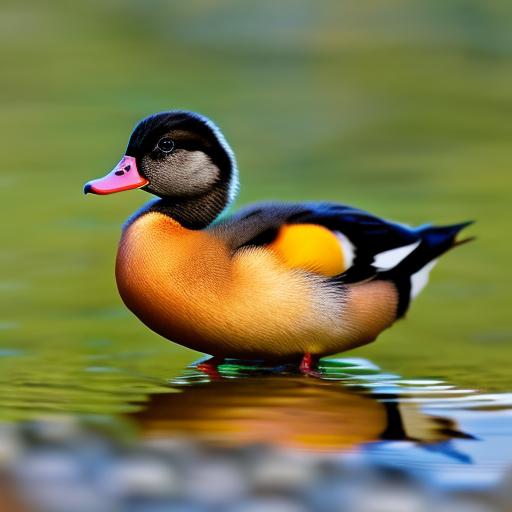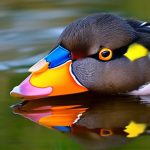Miniature duck breeds are small-sized ducks that have been selectively bred to be smaller than their standard-sized counterparts. They are often kept as pets due to their adorable appearance and friendly nature. These ducks make great pets for both experienced and first-time duck owners.
One of the main reasons why miniature duck breeds make great pets is their size. Unlike standard-sized ducks, miniature ducks are small and compact, making them easier to handle and care for. They require less space and can be kept in smaller enclosures, which is ideal for people with limited outdoor space.
In addition to their size, miniature duck breeds are known for their friendly and sociable nature. They are often described as being curious, affectionate, and easy to tame. They enjoy human company and can form strong bonds with their owners. This makes them a popular choice for families with children or individuals looking for a companion animal.
Key Takeaways
- Miniature duck breeds are smaller versions of standard duck breeds, with a maximum weight of around 4 pounds.
- Miniature ducks have been bred for centuries, with evidence of their existence dating back to ancient China.
- Miniature ducks are known for their friendly and curious personalities, as well as their adaptability to different living situations.
- Popular miniature duck breeds include the Call duck, the East Indie duck, and the Miniature Crested duck.
- When caring for miniature ducks, it is important to provide them with a safe and secure living space, a balanced diet, and regular veterinary check-ups.
The History of Miniature Duck Breeds
The history of miniature duck breeds can be traced back to the selective breeding practices of farmers and breeders. These ducks were originally bred for agricultural purposes, particularly for egg production and meat. Over time, breeders began to focus on creating smaller-sized ducks that were more suitable for backyard or urban farming.
The development of miniature duck breeds played a significant role in agriculture. Their smaller size made them easier to handle and manage compared to larger ducks. They required less space and resources, making them more cost-effective for farmers. Additionally, their high egg production made them valuable for both commercial and small-scale farming operations.
As the demand for miniature duck breeds as pets grew, breeders started focusing on improving their appearance and temperament. Today, there are several recognized miniature duck breeds that have been developed through careful breeding practices.
Characteristics of Miniature Duck Breeds
Miniature duck breeds have distinct physical characteristics that set them apart from standard-sized ducks. They are typically smaller in size, with an average weight ranging from 1.5 to 3 pounds. They have shorter legs and necks, giving them a compact and adorable appearance.
In terms of temperament, miniature duck breeds are known for being friendly, sociable, and easy to handle. They enjoy human company and can form strong bonds with their owners. They are often described as being curious and intelligent, which makes them trainable and responsive to commands.
Popular Miniature Duck Breeds
There are several popular miniature duck breeds that are commonly kept as pets. Each breed has its own unique characteristics and traits that make them special.
One popular miniature duck breed is the Call Duck. Call Ducks are known for their small size and distinctive quack, which is higher-pitched compared to other duck breeds. They come in a variety of colors and patterns, including white, gray, and mallard. Call Ducks are friendly and sociable, making them great pets for families.
Another popular miniature duck breed is the Indian Runner Duck. Indian Runners are known for their upright posture and slender body shape. They have a unique walking style, where they run rather than waddle like other ducks. Indian Runners come in a variety of colors, including black, white, fawn, and chocolate. They are active and energetic ducks that require plenty of space to roam.
The Miniature Crested Duck is another popular breed known for its distinctive crest on top of its head. They come in a variety of colors, including black, blue, chocolate, and silver. Miniature Crested Ducks are friendly and sociable, making them great pets for families with children.
Housing and Care for Miniature Duck Breeds
When it comes to housing miniature duck breeds, it’s important to provide them with a safe and comfortable environment. They require a secure enclosure that protects them from predators and provides shelter from the elements. The enclosure should have a solid floor to prevent their feet from getting wet and muddy.
Miniature duck breeds also need access to water for swimming and bathing. A small pond or pool should be provided within their enclosure. It’s important to regularly clean and change the water to maintain good hygiene.
In terms of care, miniature duck breeds require regular grooming and maintenance. Their feathers should be checked for any signs of damage or parasites. They should also be provided with a balanced diet and fresh water at all times.
Feeding Miniature Duck Breeds

Miniature duck breeds have similar dietary requirements to standard-sized ducks. They require a balanced diet that includes a combination of commercial duck feed, fresh vegetables, and insects.
Commercial duck feed should make up the majority of their diet. It is specifically formulated to meet the nutritional needs of ducks and provides them with essential vitamins and minerals. Fresh vegetables such as lettuce, spinach, and peas can be offered as treats or supplements to their diet.
In addition to commercial feed and vegetables, miniature duck breeds also enjoy foraging for insects and worms. This helps to keep them mentally stimulated and provides them with additional protein.
It’s important to provide miniature duck breeds with fresh water at all times. They require water for drinking, swimming, and bathing. The water should be changed regularly to maintain good hygiene.
Health Concerns for Miniature Duck Breeds
Like all animals, miniature duck breeds are susceptible to certain health issues. It’s important to be aware of these potential health concerns and take appropriate measures to prevent and treat them.
One common health issue in ducks is respiratory infections. These can be caused by poor ventilation, damp bedding, or exposure to cold drafts. To prevent respiratory infections, it’s important to provide a well-ventilated and dry environment for miniature duck breeds.
Another common health issue in ducks is bumblefoot, which is an infection of the foot caused by bacteria. Bumblefoot can be prevented by providing a clean and dry environment for ducks to walk on. Regularly inspecting their feet and keeping their bedding clean can also help prevent this condition.
Other health concerns for miniature duck breeds include parasites, such as mites and worms, as well as nutritional deficiencies. Regular veterinary check-ups and a balanced diet can help prevent these health issues.
Breeding Miniature Duck Breeds
Breeding miniature duck breeds requires careful planning and consideration. It’s important to have a suitable breeding pair and provide them with the right conditions for successful breeding.
To breed miniature duck breeds, it’s important to have a male and female of the same breed. They should be healthy and of breeding age, which is typically around 6 to 8 months old.
The breeding pair should be provided with a suitable nesting area, such as a nesting box or sheltered area. The nesting area should be filled with clean bedding material, such as straw or wood shavings.
Once the female lays her eggs, they should be left undisturbed until she has finished laying. The eggs should then be collected and placed in an incubator or under a broody duck for hatching.
It’s important to monitor the breeding pair and provide them with proper nutrition and care throughout the breeding process. Regular veterinary check-ups can also help ensure the health and well-being of both the breeding pair and their offspring.
Training and Socializing Miniature Duck Breeds
Training miniature duck breeds is possible with patience, consistency, and positive reinforcement. They are intelligent animals that can learn basic commands and tricks.
To train a miniature duck breed, it’s important to start with simple commands such as “sit” or “stay.” Use treats or rewards to reinforce positive behavior. It’s important to keep training sessions short and fun to maintain their interest and attention.
Socializing miniature duck breeds with other pets and people is also important. They should be introduced to other animals and people gradually and in a controlled environment. Positive experiences and interactions can help them become more comfortable and confident in different social situations.
Is a Miniature Duck Breed Right for You?
In conclusion, miniature duck breeds make great pets for those looking for a small-sized and friendly companion. They are easy to handle and care for, making them suitable for both experienced and first-time duck owners.
Before getting a miniature duck breed as a pet, it’s important to consider factors such as space requirements, time commitment, and the availability of resources. Miniature duck breeds require a suitable enclosure, regular grooming, and a balanced diet.
Overall, owning a miniature duck breed can be a rewarding experience for those willing to provide the necessary care and attention. They are adorable, sociable, and intelligent animals that can bring joy and companionship to their owners.
If you’re interested in miniature duck breeds, you might also want to check out this informative article on Poultry Wizard about the best kind of coop for chickens. Having a suitable coop is essential for the well-being and safety of your feathered friends. This article provides valuable insights and tips on choosing the right coop design, size, and materials to ensure your chickens are comfortable and protected. To learn more, click here: https://poultrywizard.com/keeping-chickens/what-kind-of-coop-is-best-for-chickens/.
FAQs
What are miniature duck breeds?
Miniature duck breeds are small-sized ducks that are bred for their ornamental value and as pets. They are smaller in size compared to standard duck breeds and are known for their unique and attractive appearance.
What are some popular miniature duck breeds?
Some popular miniature duck breeds include Call ducks, Mandarin ducks, Wood ducks, and Carolina ducks. These breeds are known for their unique colors, patterns, and feather shapes.
What is the average size of miniature duck breeds?
The average size of miniature duck breeds is around 1-2 pounds, with a height of 8-12 inches. They are significantly smaller than standard duck breeds, which can weigh up to 10 pounds and have a height of 20-30 inches.
What is the lifespan of miniature duck breeds?
The lifespan of miniature duck breeds varies depending on the breed and their living conditions. On average, they can live up to 5-10 years with proper care and nutrition.
What is the temperament of miniature duck breeds?
Miniature duck breeds are known for their friendly and social temperament. They are often kept as pets and can be trained to follow simple commands. However, they can also be easily frightened and require a safe and secure living environment.
What is the diet of miniature duck breeds?
The diet of miniature duck breeds consists of a combination of commercial duck feed, fresh vegetables, and fruits. They also require access to clean water for drinking and swimming.
What is the breeding process for miniature duck breeds?
The breeding process for miniature duck breeds is similar to that of standard duck breeds. It involves selecting healthy and genetically diverse breeding pairs, providing them with a suitable nesting area, and incubating the eggs until they hatch. However, due to their small size, miniature duck breeds may require additional care and attention during the breeding process.
Meet Walter, the feathered-friend fanatic of Florida! Nestled in the sunshine state, Walter struts through life with his feathered companions, clucking his way to happiness. With a coop that’s fancier than a five-star hotel, he’s the Don Juan of the chicken world. When he’s not teaching his hens to do the cha-cha, you’ll find him in a heated debate with his prized rooster, Sir Clucks-a-Lot. Walter’s poultry passion is no yolk; he’s the sunny-side-up guy you never knew you needed in your flock of friends!







